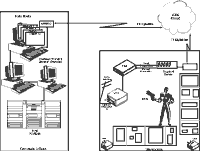The Problem:
A custom woodwork company had a massive, complex inventory control system. Transactions were continually flying between nearly one hundred Intermec Janus hand-held computers in any of their twelve facilities and their four General Automation (GA) minicomputer systems (later upgraded to High Availability, AIX based, IBM RS/6000 systems). When the Pick-Basic software used by these four computers crashed - and they did often - there was no way of storing or saving any transactions in route; nor could they continue sending while the problem was being rectified. They called upon Current Directions to develop a reliable system to guarantee delivery of all transactions. They expressed satisfaction with the Janus hand-held computers they were using, but found the IRL program for the Januses difficult for their in-house people to code and maintain.
The Solution:

Current Directions developed a fault-tolerant, store and forward packet routing system using 'standard', Intel based, hardware under the control of the Red Hat Linux operating system.
The router interfaced to the Intermec 9180 RF concentrators through RS232 terminal servers located throughout the country via a TCP/IP based WAN.
Each facility was equipped with Intermec Janus JR2020RF hand held computers communicating with the (local) 9180 concentrators over 900Mhz RF via Intermec 9181 base station transceivers.
The basic operation of the system works as follows; The employee scans or key enters information using the Janus hand-held computer. The RF concentrator receives the data and then sends it to its local terminal server via a RS232 signal. This data is then routed into a T1 line connected via frame relay to the corporate headquarters. The data is then sent to the Linux router which logs the transaction to it's own file system before forwarding it to one of four host servers. The host responds by sending a reply back to the router which forwards the response on to the requesting Janus device.
A robust status screen is presented on the router console for quick and simple identification of communication errors and bottlenecks. If any of the host systems are not able to respond immediately, the router queues the transaction on it's own file system, and waits for the host to resume accepting transactions. The router then sends a confirmation to the end-user that the data has been properly accepted so that they may continue working.
The Benefits:
All of the transactions are being captured reliably, and when any host system goes down, the transactions for that host are saved and sent later, or automatically re-routed to another (available) host. The main screen of the router program indicates the status of all connections from each location and to each host. By monitoring a single screen, the operators can now identify the source of problems. Facilities are provided so that the operator can easily re-route all of the data flow from one host to another, or from one Intermec 9180 RF concentrator to another. Because this data flow was considered to be mission critical, an inexpensive, duplicate system was also deployed and placed on 'stand-by'.
In addition to the above, Current Directions also re-coded all the clients existing 'home-grown', IRL based, Janus programs in the C language, making the entire system more reliable, flexible, and easy to use.
|
|